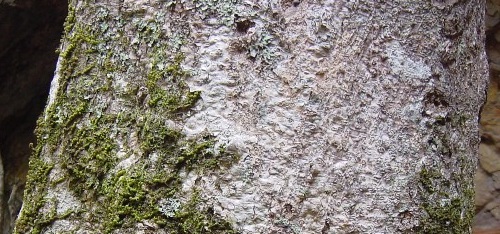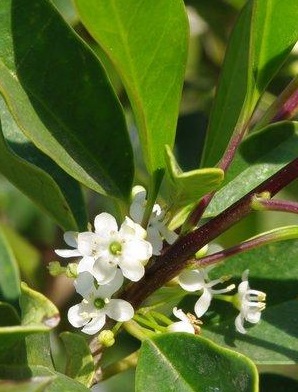Cape Holly – Ilex mitis
(Without)
Cape Holly occurs in Eastern, Central and Southern Africa, distributed throughout the forests along the mountain ranges from Transvaal to the Cape Peninsula. It is described 
The Tree
The Cape Holly is a medium to large evergreen tree of up to 30m tall, with a dense crown and gracefully drooping branches.
The trunk is smooth and the bark light grey or whitish , with raised corky spots. Young branchlets can be tinged with purple, becoming whiter with age. There are many medicinal uses for the bark.
The leaves are simple, alternate, leathery and dark green above and paler
green below. The leaf stalk is channeled above and usually reddish purple. The midrib is sunken above and prominent below and the side veins are looping. The margins are usually entire, but could have a few teeth towards the apex.
The flowers ar
The fruit takes a long time to develop. It is a spherical shiny berry, turning pink and then dark crimson as it ripens – about 6 mm in diameter. March – May.
The ripe fruit is edible, but can be bitter and is eaten by birds. If the fresh leaves are rubbed together in water, they produce a lather. It is said that early Knysna woodcutters used it for washing in the forest streams. It is also believed that the presence of this tree is an indication of underground water near the surface. The Knysna elephants reportedly showed a special liking for this tree.
Properties
The heartwood and sapwood are white and not distinguishable with large medullary rays which give a silvery mottled effect. It is close-grained, medium-hard and medium-heavy. The wood darkens to a honey colour with age and oiling. The wood has a fine and even texture with a straight grain and is slightly lustrous.
Woodworking Properties
The wood saws easily. It planes well, to a slightly lustrous surface. It glues well and takes a good paint or varnish finish. The wood peels easily for decorative veneer and plywood. The colour of the wood makes it ideal for inlay work.

It is used in furniture making and for paneling. Suitable for various implements and also in demand for heels of ladies’ shoes. Formerly used for buck boards of wagons.
Other uses include – boat building, domestic flooring, cabinetry, interior trimming, decorative veneer, decorative boxes, vats, carving and turnery.
Green weight: 880 kg/m3
Dry weight: 600 kg/m3
Source: Trees of the Garden Route / Elna Venter
Southern African Woods / Stephanie Dyer, Barry James & Danielle James
If you are looking to buy wood, please click here to visit our Timber slab sales page.

